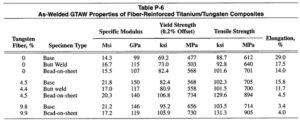Polymeric composites consist of reinforcing fibers bound together by the cohesive and adhesive characteristics of a resin composite matrix. The purpose of the matrix is to transfer the load to and between fibers.
The matrix keeps the reinforcing fibers in the proper orientation and position so that they can carry the intended loads and also helps distribute the loads more uniformly throughout the material.
Polymeric composite materials were developed because no single, homogeneous material could be found that had all of the desired properties for a given application. They were developed initially for aerospace applications.
Some of the common materials used as fibers are steel, tungsten, E-glass, S-glass, silicon carbide whiskers (small monocrystalline materials), boron, graphite, Kevlar, and aluminum oxide. The most common types of resins are epoxy resins, polyamide resins, polyester resins, and thermoplastic resins.
Polymeric composites can be classified according to reinforcement forms, such as particulate-reinforced, fiber-reinforced, or laminate composites.
Welding is accomplished through diffusion and entanglement of the matrix molecules. There are two general groups of polymeric matrices: thermosetting-matrix and thermoplastic-matrix. Thermosetting-matrix composites cannot be welded because of the
cross-linking of the polymer chains; they can be joined only by mechanical fastening or adhesive bonding, or both. However, in thermoplastic matrix composites, the polymer chains are held together by secondary chemical bonds that weaken and break when heated, freeing the chains to move and diffuse. Therefore, thermoplastic composites can be welded or fusion bonded.
Most welding processes that are suitable for joining thermoplastics can also be used to fusion bond composites. The processes for welding plastics and composites can be classified in two groups. The first group uses an external heat source, such as hot plate welding, hot gas welding, resistively or inductively heated implants, and infrared or laser welding. Processes in the second group use internal heat generation and
include dielectric and microwave heating, friction
heating (spin welding), vibration welding, and ultra-
sonic welding.
Gas metal arc welding (GMAW), gas tungsten arc welding (GTAW), laser beam welding (LBW), electron beam welding (EBW), resistance welding (RW), friction welding (FW), and diffusion welding and brazing can be used to weld composite matrices.
Following are five steps involved in welding composites:
(1) Surface preparation to remove contaminants
(2) Heating and melting of the thermoplastic matrix on the weld surfaces
(3) Pressing to promote flow and wetting
(4)Intermolecular diffusion and entanglement of the polymer chains
(5)Cooling and resolidification of the thermoplastic The as-welded properties of GTAW in fiber-rein- forced Ti/W are shown in Table P-6.

Common Matrix Alloys. Because of their origins in the aerospace industry, most metal-matrix composites (MMCs) emphasize high performance with light weight. As a result, most development time and resources have been put into low-density alloys. Magnesium has the lowest density among the commonly used light metals, however, it creeps at low temperatures, has relatively low strength, and is prone to corrosion. Titanium is more than twice as strong as aerospace grade aluminum alloys. Its exceptional temperature and corrosion resistance make titanium a favored choice for demanding environments, where its high cost is justifiable.
Aluminum is the most widely used matrix material because it is easy to process, inexpensive, light in weight, and can be alloyed to fairly high strengths. It retains useful strength at moderate temperatures and has excellent corrosion resistance.
Common Reinforcements. The choice of reinforcement material generally depends on the desired properties of the composite, its compatibility with the matrix material, and the MMC processing route. Among the reinforcement materials used for metal matrix composites are silicon carbide, aluminum oxide, titanium carbide, and boron carbide, graphite, and titanium diboride.
Because more aluminum metal-matrix composites are produced than all the other alloys combined, the Aluminum Association developed a standard designation system for MMCs that has been adopted by the American National Standards Institute. ANSI 35.5-1993 provides that aluminum-matrix MMCs be identified with designations in the following format:
matrix/reinforcement/volume%form
where :
matrix = metal or alloy designation of matrix
reinforcement = chemical formula for reinforcement
volume% = volume percentage (without the % sign)
form = f, fiber or filament
c, chopped fiber
w, whiskers
p, particulate
Safety. Regardless of the material being welded, standard welding safety practices should be followed at all times. Welding should take place in a well-ventilated area and operators should use appropriate eye protection and safety equipment. For general welding safety procedures, refer to ANSUASC 249.1, Safety in Welding, Cutting and Allied Processes.
